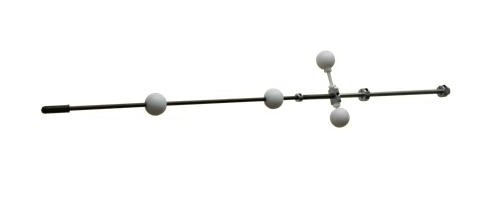Table of Contents
Digitizing Pointer
NOTE: C-Motion no longer makes or sells pointers (since 2016).
There are two general types of pointers.
- Spring loaded - allows Visual3D to recognize when the tip location should be assigned to a landmark; e.g. when the spring is compressed.
- Static - The user must select a button to notify Visual3D to assign the tip location to a landmark.
The objective for using the pointer is to identify anatomical landmarks without having to place motion capture markers at the location. There are many reasons for using a pointer instead of a marker.
- Some anatomical landmarks are obscured by fat (e.g. the Pelvis ASIS markers for overweight subjects
- Some anatomical landmarks are obscured from the cameras (e.g. some medial landmarks)
- Some anatomical landmarks are close together (e.g. on the foot) and tracking the markers can be challenging
- In order to attach markers, the subject must expose that part of the body, which can be uncomfortable for some subjects
- If a tracking marker falls off, or is moved inadvertently, after the anatomical markers have been removed. The standing trial must be recorded again, which requires all anatomical landmarks to be replaced.
Visual3D Landmarks
Each landmark is identified relative to 3 markers that are attached rigidly to the segment that the landmark is associated with.
Computing the location relative to 3 markers that are tracked by the cameras means that the subject can move during the data capture and the landmark will move relatively.
This can be especially useful for defining the static trial because you can orient the subject so that there is a better view of the markers for the motion capture system.
An example of the landmark definition in Visual3D is:
Landmark Name: _RL.WRIST (e.g. Right Lateral Wrist)
Starting Point: RWR1
Ending Point: RWR2
Lateral Object: RWR4
Offset using the Following ML/AP/AXIAL Offsets
ML: -0.00809
AP: 0.0238
AXIAL: -0.0209
This landmark is created relative to three tracking markers (RWR1, RWR2, RWR4) with a fixed offset. The location of this landmark can be computed for all movement trials assigned to this model.
For non-Visual3D users
A new C3D file can be exported that includes these landmarks as if they were Motion Capture markers. This file can now be used by other software that doesn't recognize Visual3D landmarks. The C3D Parameter description for these virtual markers indicates that it was created using Visual3D's Pointer module.
Tutorials
Define and Create Digitizing Landmarks
1. Digitizing Pointer Post Processing - This tutorial explains the step by step process of defining a digitizing landmark, defining the pointer, and using a dynamic C3D file to identify the landmark.
Defining landmarks
1. Create_Digitizing_Landmarks - Defining the digitizing landmark, this is Step 2 of the digitizing landmark tutorial
2. Digitizing Pointer Configuration - Defining the digitizing pointer configuration so that the TIP of the pointer can be computed.
Custom Pointers
1. Computing Custom Digitizing Pointer Configuration - Create a custom digitizing pointer.
2. CalTester Rod as a Digitizing Pointer - The CalTester rod may also be used as a digitizing pointer.
3. Digitizing Pointer from Streaming Data - Define a pointer in real time.
Additional Tutorials
1. Introduce Missing Digitizing Pointer Markers - A method to re-create the digitizing pointer in a static trial if the landmarks do not exist in the static trial but exist in another static trial
2. Pointer Tip Landmarks - Describes the process to manually create the tip of a pointer as a landmark.

